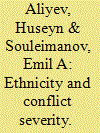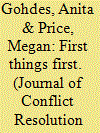| Srl | Item |
| 1 |
ID:
101855


|
|
|
|
|
| Publication |
2011.
|
| Summary/Abstract |
This article examines how different components of globalization affect the death toll from internal armed conflict. Conventional wisdom once held that the severity of internal conflict would gradually decline with the spread of globalization, but fatalities still remain high. Moreover, leading theories of civil war sharply disagree about how different aspects of globalization might affect the severity of ethnic and nonethnic armed conflicts. Using arguments from a variety of social science perspectives on globalization, civil war, and ethnic conflict to guide the analysis, this article finds that (1) economic globalization and cultural globalization significantly increase fatalities from ethnic conflicts, supporting arguments from ethnic competition and world-polity perspectives, (2) sociotechnical aspects of globalization increase deaths from ethnic conflict but decrease deaths from nonethnic conflict, and (3) regime corruption increases fatalities from nonethnic conflict, which supports explanations suggesting that the severity of civil war is greater in weak and corrupt states.
|
|
|
|
|
|
|
|
|
|
|
|
|
|
|
|
| 2 |
ID:
097776


|
|
|
|
|
| Publication |
2010.
|
| Summary/Abstract |
There has been a staggering decline in battle deaths in East Asia. Several recent studies have testified to this trend by referring to it as East Asian Peace. The decline in traditional conflict battle deaths does not, however, constitute peace. It could be possible that battle deaths have merely moved to less traditional types of conflict. The purpose of this article is to see whether the decline in battle deaths has brought about genuine peace.
|
|
|
|
|
|
|
|
|
|
|
|
|
|
|
|
| 3 |
ID:
164823


|
|
|
|
|
| Summary/Abstract |
How does the presence of armed pro-regime groups affect conflict lethality? This study examines the relationship between ethnicity, militia violence and conflict lethality in civil wars. We emphasise that differences in whether pro-regime militias were recruited in accordance with their ethnicity or not are critical in their influence upon conflict lethality, which we estimate in battlefield deaths. To that end, we categorise militias into groups recruited on their ethnic basis (co-ethnic militias) and those recruited regardless of their ethnicity (non-ethnic militias). We hypothesise that conflicts are more lethal when non-ethnic militias are involved. We link higher number of battle-deaths in conflicts with non-ethnic militias with the militia use of one-sided violence against civilians. Co-ethnic militias – that is militias recruited from the same ethnicity as rebels – are deployed amongst their co-ethnics and therefore tend to target civilians less than non-ethnic militias. This militia–civilian relationship has direct impact on conflict severity. To test our hypotheses we conduct global statistical analysis of 84 intrastate conflicts from 1989 to 2014.
|
|
|
|
|
|
|
|
|
|
|
|
|
|
|
|
| 4 |
ID:
125139


|
|
|
|
|
| Publication |
2013.
|
| Summary/Abstract |
We address weaknesses in the Peace Research Insitute Oslo (PRIO) Battle Deaths Dataset, and as a result draw contradicting conclusions to those presented by Lacina and Gleditsch. Our analysis focuses on the availability of data on battle deaths within specific conflict-years and problems encountered when data from multiple types of sources are combined. We repeat Lacina, Gleditsch, and Russett's analysis of battle deaths over time, with an attempt to provide a more robust model and incorporate an estimate of the uncertainty present in the PRIO Battle Deaths Dataset. This reanalysis reveals that the data used to establish the PRIO Battle Deaths Dataset does not offer a clear answer as to whether battle deaths have decreased or increased since the end of the Second World War. We contend that while the PRIO Battle Deaths Dataset offers the most comprehensive assembly of battle deaths data available to date, it is not suitable for analysis across countries or over time.
|
|
|
|
|
|
|
|
|
|
|
|
|
|
|
|
| 5 |
ID:
145149


|
|
|
|
|
| Summary/Abstract |
What does taking dead bodies seriously tell us about the state of global security studies? Dead bodies play different roles in conventional, human, and critical security studies and thus thinking about them opens conversations among these different approaches. This paper pushes further to argue that scholars should think about the global dead as an analytical category. It demonstrates that doing so will allow us to rethink the measurement of war casualties, and examine the assumptions embedded in quantitative casualty data, the ethnography of these numbers, and the politics of representing them. Establishing the dead as an analytical category also widens the lens of dead body management to examine how dead bodies are not only objects but also subjects of security. This should lead us to ask about the politics behind how they are secured and governed, as well as the political and legal structures in place to manage them. Corpses matter for how we define security and they matter a great deal for a wide variety of security behavior. Up until now, security scholars have treated them implicitly but we can understand much more about the politics of the dead if we make them an explicit category of study.
|
|
|
|
|
|
|
|
|
|
|
|
|
|
|
|
| 6 |
ID:
147495


|
|
|
|
|
| Summary/Abstract |
This paper analyses the statistical distribution of war sizes. Using a new methodology we find moderate support for a Pareto-type distribution (power law), considering data from different sources (COW and UCDP) and periods. A power law is a plausible model for the size distribution of a pool of all wars and a sample of wars in many years, although the log-normal distribution is a plausible alternative model that we cannot reject. The random growth of conflicts could generate both types of distribution. We study the growth rates of battle deaths and random growth cannot be rejected for most of the distribution, although the results also reveal a clear decreasing pattern; the growth of deaths declines faster if the number of initial deaths is greater.
|
|
|
|
|
|
|
|
|
|
|
|
|
|
|
|